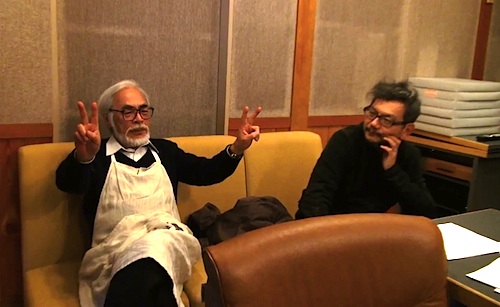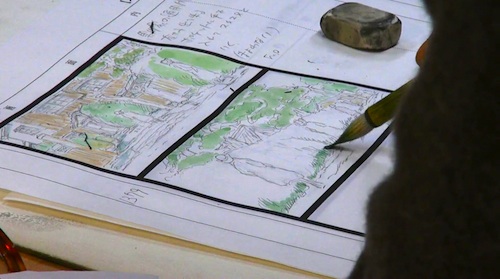
By Joe Bendel. For millions of animation fans, Studio Ghibli is like Disney without the weird cryogenic baggage. Year after year, Hayao Miyazaki and his team of animators have produced absolute classics that transcend genre. He has now apparently, by-and-large, for the most part, more-or-less retired, but Mami Sunada documented the master at work on his final masterwork, The Wind Rises. Sunada quietly observes the Studio Ghibli comings and goings, but still captures plenty of drama in The Kingdom of Dreams and Madness, which screens during this year’s DOC NYC.
Studio Ghibli might only continue as a licensing company, but it ended its original productions on artistic high notes. Both Miyazaki’s The Wind Rises and Isao Takahata’s The Tale of the Princess Kaguya are extraordinarily accomplished capstones to their legendary careers. While Miyazaki’s farewell film was a monster hit at the Japanese box-office, Takahata’s was not. They were also supposed to be released simultaneously, but even at the start of Kingdom, everyone realizes that is highly unlikely to happen.
While there is plenty of pencil-sharpening and studious sketching going on in Kingdom, real conflict emerges between the venerable Miyazaki and the largely unseen Takahata, who gave Miya-san his start in the business decades ago at the Tohei studio. They share an awful lot of history together, but their working methods could not be further apart.
Somehow, as Sunada illustrates in detail, Miyazaki is able to put inspiration on a timetable, which you have to respect, because he made Spirited Away. In contrast, it happens when it happens for Takahata, which you have to respect, because he made Grave of the Fireflies—unless you happen to be Miyazaki. Even though Sunada observes events almost entirely from Miyazaki’s perspective, it is clear their relationship is very complicated. While the film consistently shows how comfortable Miyazaki is in his role as part studio task-master and part twinkly-eyed ambassador of goodwill, whenever Takahata’s delays are mentioned, he sounds like Seinfeld cursing “Newman.” Yet, with his next breath, he is likely to praise his former mentor’s past achievements.

That strange dynamic truly elevates Kingdom above yet another dry process doc, like Farocki’s Sauerbruch Hutton Architects. It also helps that director-editor-cinematographer Sunada is a legit filmmaker with an eye for the telling moment rather than an overawed fan cranking out a DVD extra. As when she chronicled her father’s final days in Death of a Japanese Salesman, she is quite sensitively attuned to the human drama that accompanies any sort of finality.
There are very few animated clips seen throughout Kingdom, which speaks highly of Sunada’s confidence in her subjects. It is justified. Miyazaki is a thoroughly engaging presence, as are longtime producer Ghibli producer-peacemaker Toshio Suzuki and Evangelion animator Hideaki Anno, who gave voice to The Wind Rises’ idealistic protagonist. Sunada documents some true cinema history, ultimately marking the end of an era. A fitting coda to a great career, The Kingdom of Dreams and Madness is recommended for all serious students of animation when it screens this Sunday morning (11/16) at the SVA Theatre, as part of DOC NYC 2014.
LFM GRADE: A-
Posted on November 11th, 2014 at 7:52pm.